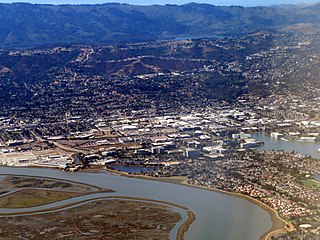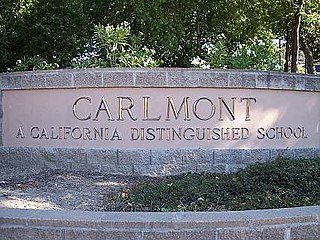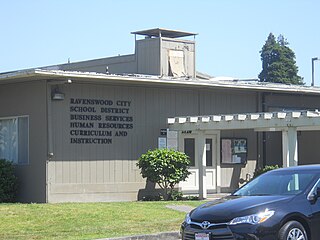
Palo Alto is a charter city in the northwestern corner of Santa Clara County, California, United States, in the San Francisco Bay Area, named after a coastal redwood tree known as El Palo Alto.

Menlo Park is a city at the eastern edge of San Mateo County within the San Francisco Bay Area of California in the United States. It is bordered by San Francisco Bay on the north and east; East Palo Alto, Palo Alto, and Stanford to the south; and Atherton, North Fair Oaks, and Redwood City to the west. It had 33,780 residents at the 2020 United States census. It is home to the corporate headquarters of Meta, and is where Google, Roblox Corporation and Round Table Pizza were founded. The train station holds the record as the oldest continually operating train station in California. It is one of the most educated cities in California and the United States; nearly 70% of residents over 25 have earned a bachelor's degree or higher.

Belmont is a city in San Mateo County in the U.S. state of California. It is in the San Francisco Bay Area, on the San Francisco Peninsula about halfway between San Francisco and San Jose. Known for its wooded hills, views of the San Francisco Bay and stretches of open space, Belmont is a quiet residential community in the midst of the culturally and technologically rich Bay Area. It was originally part of Rancho de las Pulgas, for which one of its main roads, the Alameda de las Pulgas, is named. The city was incorporated in 1926. Its population was 28,335 at the 2020 census.

East Palo Alto is a city in San Mateo County, California, United States. As of the 2020 census, the population of East Palo Alto was 30,034. It is situated on the San Francisco Peninsula, roughly halfway between the cities of San Francisco and San Jose. To the north and east is the San Francisco Bay, to the west is the city of Menlo Park, and to the south the city of Palo Alto. Despite being called "East" Palo Alto, the city is directly north of Palo Alto. While often incorrectly assumed to be part of the city of Palo Alto, East Palo Alto has always been a separate entity since its founding as an unincorporated community and its incorporation in July 1983. It is also in San Mateo County, while Palo Alto is in Santa Clara County. The two cities are separated only by San Francisquito Creek and, largely, the Bayshore Freeway. The revitalization projects in 2000, and high income high-tech professionals moving into new developments, including employees from Google and Facebook, have begun to eliminate the cultural and economic differences between the two cities. East Palo Alto and Palo Alto share both telephone area codes and postal ZIP codes.

Emerald Lake Hills or Emerald Hills is a census-designated place and neighborhood in unincorporated San Mateo County, in the state of California, United States. Situated among oak-studded hills between Woodside, Redwood City, and San Carlos roughly bounded by Edgewood Road, Alameda de las Pulgas, Farm Hill Boulevard, and Interstate 280. The population was 4,406 at the 2020 census and the per-capita income was $68,966, making it the 22nd wealthiest place in California and the 82nd highest income places in the United States

Redwood City is a city on the San Francisco Peninsula in Northern California's Bay Area, approximately 27 miles (43 km) south of San Francisco, and 24 miles (39 km) northwest of San Jose. Redwood City's history spans its earliest inhabitation by the Ohlone people to being a port for lumber and other goods. The county seat of San Mateo County in the heart of Silicon Valley, Redwood City is home to several global technology companies including Oracle, Electronic Arts, Evernote, Box, and Informatica. The city's population was 84,292 according to the 2020 census. The Port of Redwood City is the only deepwater port on San Francisco Bay south of San Francisco.

San Carlos is a city in San Mateo County, California, United States. The population is 30,722 per the 2020 census.

College of San Mateo (CSM) is a public community college in San Mateo, California. It is part of the San Mateo County Community College District. College of San Mateo is located at the northern corridor of Silicon Valley and situated on a 153-acre site in the San Mateo hills. The campus was designed by architect John Carl Warnecke. The college currently serves approximately 10,000 day, evening and weekend students. The college offers 79 A.A./A.S. degree majors, 75 certificate programs and approximately 100 transfer areas and majors.

El Palo Alto is a coast redwood located on the banks of the San Francisquito Creek in Palo Alto, California, a city in the San Francisco Bay Area. The namesake of the city and a historical landmark, El Palo Alto is 1083 years old and stands 110 feet (34 m) tall.

Carlmont High School is a public high school in Belmont, California, United States serving grades 9–12 as part of the Sequoia Union High School District. Carlmont is a California Distinguished School.

The Sequoia Union High School District is a public union school district in the San Francisco Bay Area, primarily serving the southern San Mateo County communities of Atherton, Belmont, East Palo Alto, Ladera, San Carlos, Menlo Park, Portola Valley, Redwood City, and Woodside. The District currently serves more than 9,000 students, and also owns the radio station KCEA.

The Ravenswood City School District is a public school district headquartered in East Palo Alto, California, US. The district, in the San Francisco Bay Area, serves the communities of East Palo Alto and eastern Menlo Park. Students from this school district who continue on with public schooling matriculate to the Sequoia Union High School District. In 2008-09 it served over 4,500 students. In 2019-20 student enrollment declined to approximately 3,200 with further enrollment declines projected. In the 2021-22 school year, student enrollment is reported as approximately 2,800.

Sequoia High School is a high school in downtown Redwood City, California, United States. Today, it is one of the few schools to offer the International Baccalaureate (IB) Diploma Programme within the San Francisco Bay Area.
Tierra Linda Middle School is a middle school in San Carlos, California, United States, founded in 1953. It is one of two middle schools within the San Carlos Elementary School District, and since 2018, has served students in grades 6–8. Due to changing enrollment, the school was closed in 1982, but reopened in 2000. The school is known for its diverse and award-winning music program. It shares a campus with Mariposa Upper Elementary School and San Carlos Charter Learning Center.
San Carlos School District is a K-8 elementary school district in San Carlos, California. It consists of 2 middle schools, 4 lower elementary schools, 2 upper elementary schools, and 1 K-8 charter school, which holds the distinction of being the first charter school in California and the second in the nation. The District currently serves more than 2,600 students. After graduating from 8th grade, students typically go on to the Sequoia Union High School District, and most often to Sequoia High School or Carlmont High School.
Ravenswood High School was a public high school located in East Palo Alto, California, United States. Opened in 1958, it served the East Palo Alto area of San Mateo County until its closure in 1976. In 1958 its enrollment was 629 students. During the existence of Ravenswood, East Palo Alto was the low-income area in the shadow of its more affluent neighbors Menlo Park, Atherton and Palo Alto. The city of Palo Alto, while adjacent and sharing the same zip code, is a completely different city in Santa Clara County. Ravenswood was part of the Sequoia Union High School District, which also serves the southern San Mateo County cities of Belmont, Redwood City, San Carlos, and Woodside.
Everest Public High School is a college preparatory, tuition-free, and public charter high school in Redwood City, California, United States. The school, which was modeled after Summit Preparatory Charter High School in Redwood City, opened in August 2009 following State approval of the Everest charter.
The Tinsley Voluntary Transfer Program is a 1985 settlement of a lawsuit in which school districts surrounding the Ravenswood City School District in East Palo Alto, California agreed to accept up to 135 minority students entering grades Kindergarten through second grade from within the boundaries of the Ravenswood City School District. The surrounding school districts accepting transfer students under this settlement include:
Peninsula Athletic League (PAL) is a high school athletic conference in California, part of the CIF Central Coast Section of the California Interscholastic Federation. It comprises 17 high schools generally around San Mateo County, California. There are also nine smaller schools, designated supplemental members, of which four are located in Santa Clara County. The seventeen sports offered are divided into different divisions depending on the strength of the school's program.
TIDE Academy, commonly shortened to TIDE, is a small public high school located in eastern Menlo Park, California, United States and the newest school within the Sequoia Union High School District. Founded in 2019 with a freshmen class of 102 students, the school features specialized curriculum intended to prepare students for STEM careers. Despite drawing students from across the district's borders for its unique curricular emphasis, the school is officially neither a magnet school, nor a charter school. TIDE is a comprehensive ("traditional") high school with the full range of curriculum, clubs, sports, and administrative support as the larger high schools.













